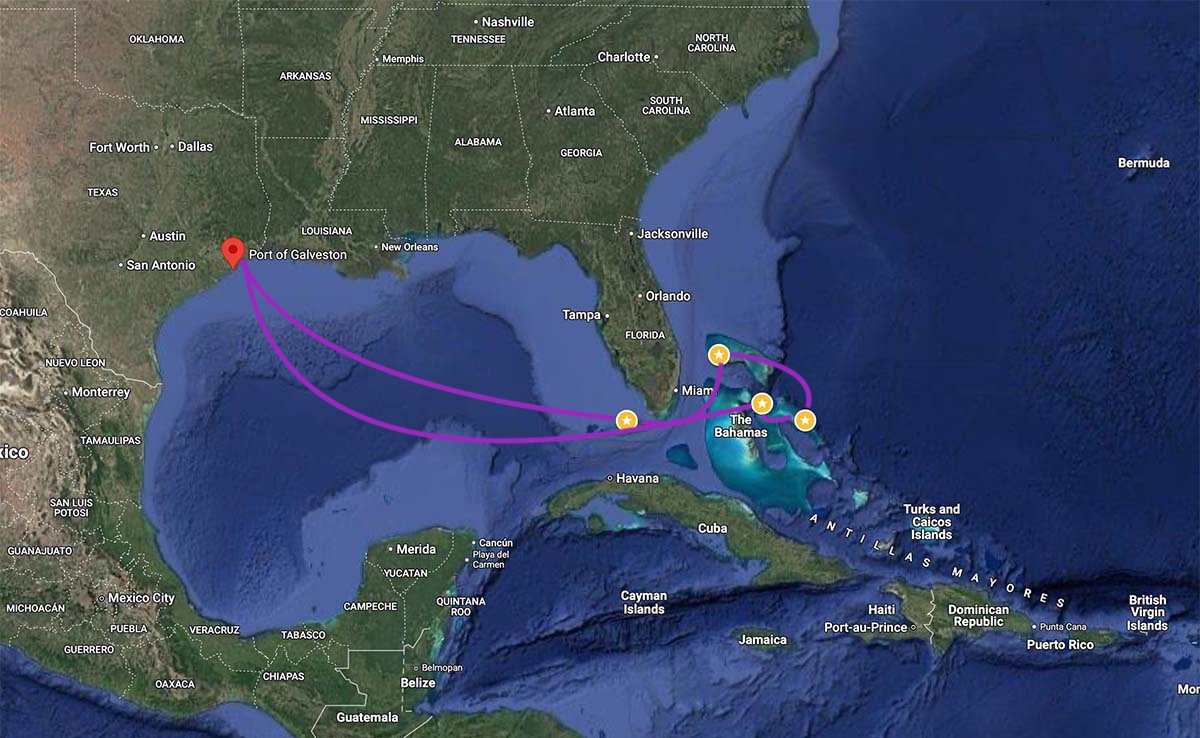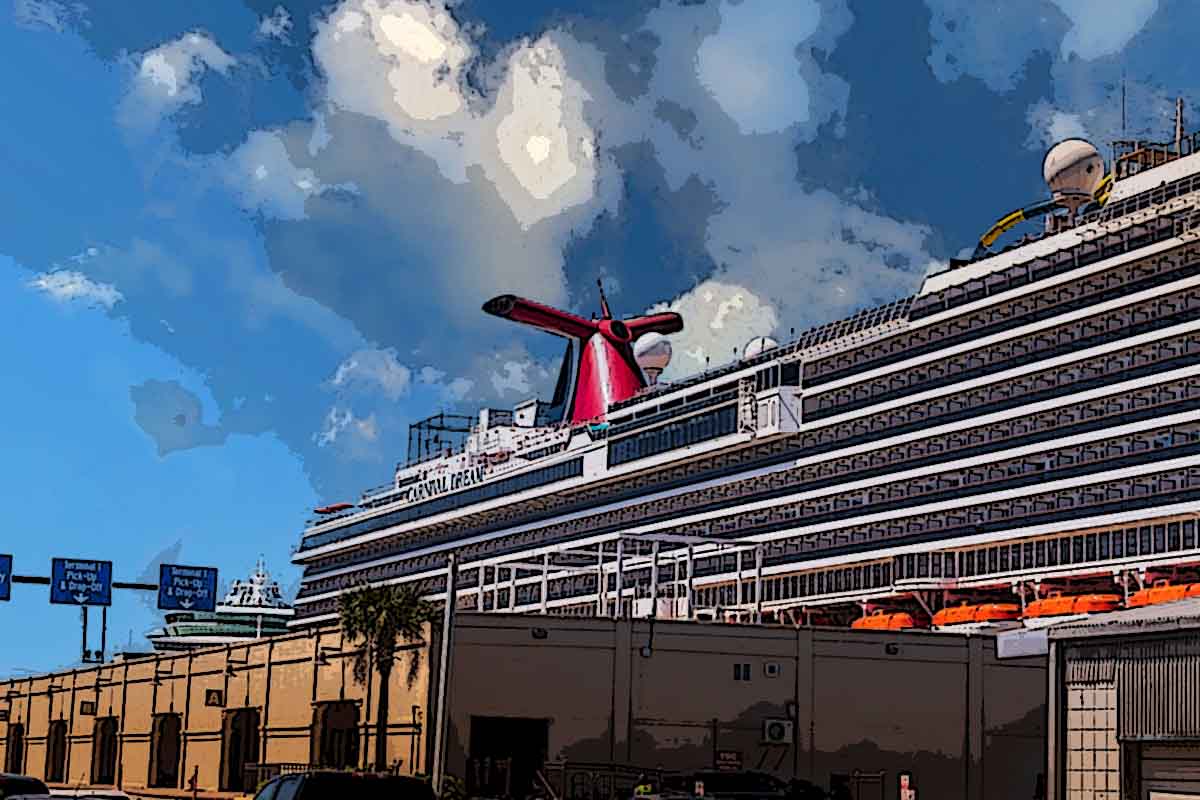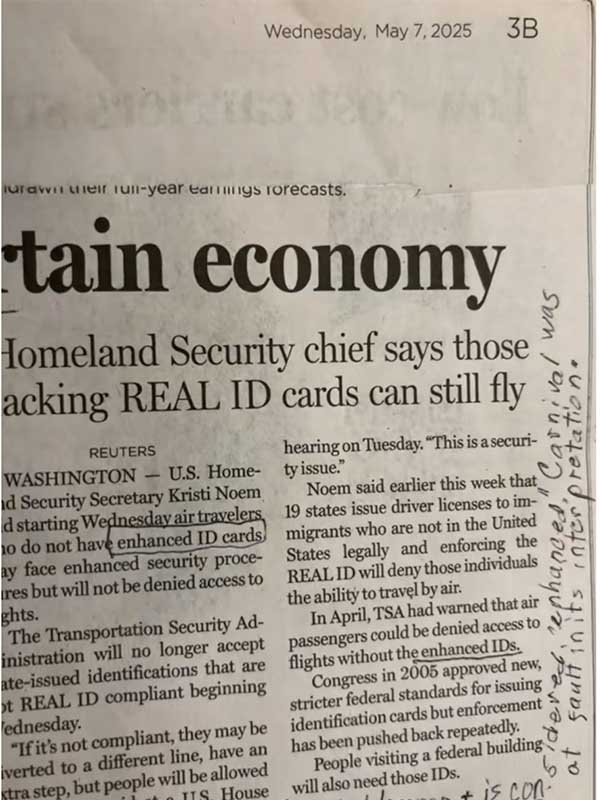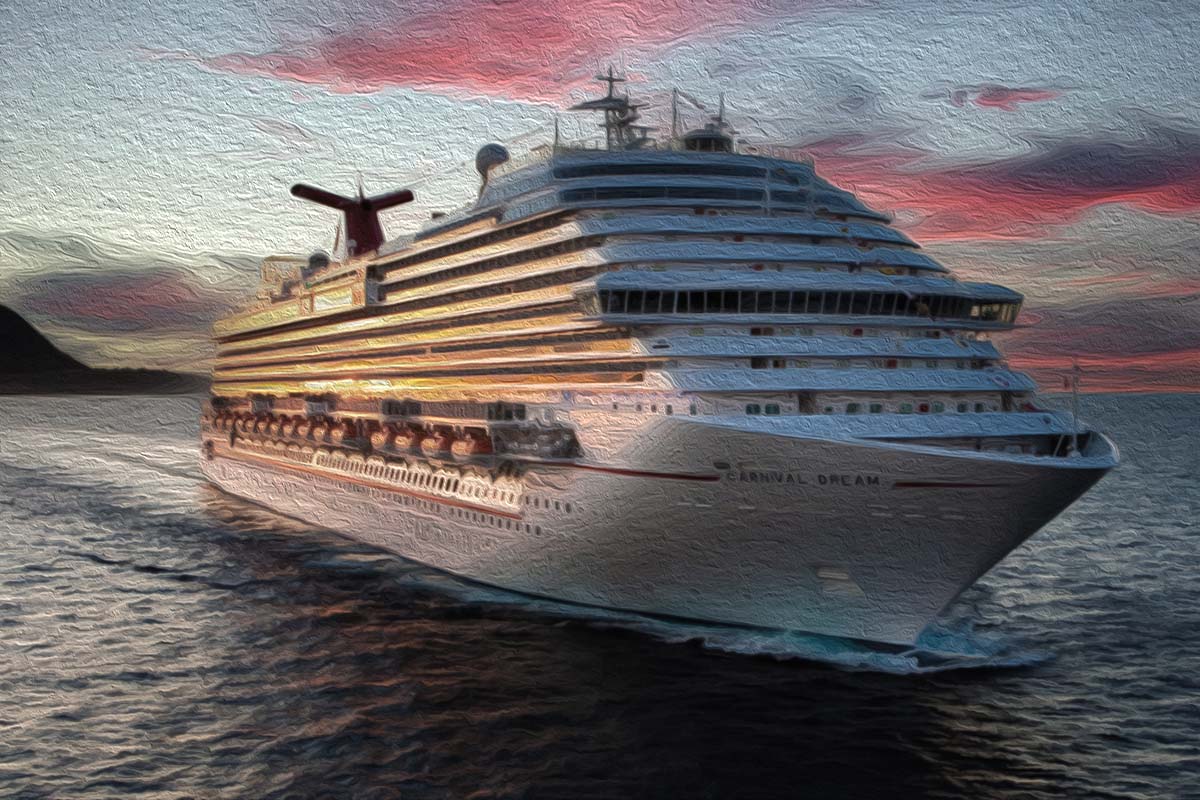Published: Updated:
Enhanced ID vs. Real ID confusion among cruise ship passengers and even crew members is at a fever pitch. For some families, that confusion has played out at cruise ports in devastating ways.
Visually, an Enhanced Driver’s License (EDL) and a Real ID driver’s license look similar. However, the differences between the two IDs are vast for travelers hoping to board their cruise ship.
Carnival Cruise Line passengers John Harrison and his family of eleven recently learned a harsh lesson about Enhanced ID. They showed up at the cruise port in Galveston, Texas, expecting to quickly “get to the fun.” But the fun never happened for Harrison and his elderly parents. They were denied boarding Carnival Dream after presenting what they presumed to be EDLs.
Carnival employees told the surprised would-be passengers that their driver’s licenses were insufficient to take the cruise. The stunned trio was soon left behind as Dream sailed away with their other eight passport-carrying family members on board.
Harrison’s next move was to ask Consumer Rescue for help.
He was sure Carnival Cruise Line had made a grave mistake by rejecting their Enhanced IDs. That error ruined a much-anticipated multigenerational family cruise and a bucket list experience for his parents.
But whose mistake really caused this terrible cruise fiasco? Since EDLs are sufficient identification to take a closed-loop cruise, that was the mystery I aimed to solve.
Jump to: Just the facts: What identification cruise passengers need
A family’s multigenerational bucket list Carnival Cruise
Last spring, the Harrisons began planning a 7-night Caribbean cruise they would take at the end of the year.
“We would all be together: My parents, my sister and her three kids, my wife and our three kids,” Harrison explained to me. “We thought of this cruise as a wonderful final family trip of this size, as my parents are now 90 and 87.”
The group would embark on their cruise from Galveston, Texas, and ring in the new year at sea aboard Carnival Dream.
At least that was the plan.

Ensuring all family members have the correct ID to cruise
The Harrisons’ closed-loop cruise would require passengers to prove their citizenship and their residency to board the ship. That meant that each adult family member* would need:
- A valid passport book with six months left before expiration -or-
- A passport card with similar validity -or-
- An Enhanced ID -or-
- A government-issued photo ID plus a U.S. birth certificate
*Children under 18 only need a birth certificate to board a closed-loop cruise.
Harrison says that his mom, Kay, noticed soon after booking the cruise that her and her husband’s passports were not valid.
“She called Carnival and asked if they must renew their passports,” Harrison told me. “Mom and Dad had just upgraded their driver’s licenses. The agent told her their newly enhanced driver’s license would be fine for the cruise.”
Harrison also didn’t have a valid passport for the cruise. So he decided he would use his new upgraded driver’s license too. Everyone else in the group had either a passport card, a passport or in the minor children’s cases, birth certificates.
With all of the cruise planning complete, the family spent the next several months looking forward to what would surely be a memorable experience.
Sadly, it would turn out to be a memorable experience, but for all of the wrong reasons.
Carnival Cruise Line: Those aren’t Enhanced IDs
Soon, the day the family had been anxiously waiting for arrived: Embarkation Day. The giant clan, with all their luggage in tow, headed to Port Galveston, arriving shortly before 1:30 pm.
There was Carnival Dream towering over the cruise terminal, just waiting for them.

The six young cousins were giddy with excitement as the adults organized and tagged their suitcases.
According to Harrison, they spent a bit of time on that task before getting in line for check-in. They assumed there was no rush as the final boarding for the cruise that day was 2:30 p.m. and they were standing in front of the check-in area.
The family didn’t know it, but they had been wasting precious minutes dawdling with their luggage. Those were minutes that might have made the difference in the final outcome that day for Harrison and his parents.
The group made their way to the check-in area sometime before 2 p.m. As the eleven passengers were processed, all received clearance to board the ship. But then the agent reached Harrison’s mom.
The Carnival representative asked for her birth certificate to go along with the driver’s license she was holding.
But Kay didn’t have a birth certificate with her, nor did Harrison or his dad.
Carnival Cruise Line: If you have a birth certificate, you can board
Harrison says he didn’t know why the agent didn’t recognize his mom’s ID as sufficient to board the ship. But he figured that could be sorted later. As the clock ticked toward 2:30, he was directed to Carnival’s “Document Retrieval Room.” There, he made some calls to get a copy of his mom’s birth certificate as the rest of the family boarded the ship.
“I was focused on my mom first. By 2:11 p.m. local time, I had a digital copy of my mom’s birth certificate,” Harrison explained. “Carnival employees told me I had to email it to a special person in the document room for validation, which I did. Then I started the same process to get copies of my dad’s birth certificate and mine.”
But within a few minutes after sending the digital copy to the document processor, another crew member tapped Harrison on the shoulder.
📬 Subscribe to:
Tales from Consumer Advocacy Land
Real stories. Real rescues. Real advice.
Join thousands of smart travelers and savvy consumers who already subscribe to Tales from Consumer Advocacy Land — the friendly weekly newsletter from Michelle Couch-Friedman, founder of Consumer Rescue. It's filled with helpful consumer guidance, insider tips, and links to all of our latest articles.

He had bad news… it was too late.
Harrison isn’t sure what time the employee stopped his race to get copies of their birth certificates. However, cruisers should know that all passengers must be checked in and on board the ship by the final boarding time.
Unfortunately, Harrison and his parents weren’t approved to board the ship by the final boarding time.
Fact: There is no flexibility with the final boarding time of your cruise. The Department of Homeland Security (DHS) requires cruise lines to provide a final manifest of all passengers on board a ship 60 minutes prior to departure.
“The worst thing about all of this was watching my mom cry at the pier,” Harrison told me. “My parents planned and paid for this cruise so we could enjoy our time together. I realize there are worse things in the world, but this was terrible for our family.”
As Carnival Dream sailed off to Key West, Harrison and his parents drove back to their home to celebrate New Year’s in a decidedly less-festive way.
Related: Traffic caused us to miss our Carnival cruise ship. How do we get a refund?
Asking Consumer Rescue for help: “Our Enhanced ID wasn’t accepted.”
When Harrison’s plea for help landed on my desk, he told me he’d been trying to get answers from Carnival for several months.
My parents booked a cruise for our family of 11. They were told by Carnival that their enhanced IDs would be sufficient for travel. So they didn’t renew their passports. When we got to the building, my mother, father, and I were denied boarding. Carnival will no longer speak to us about this. Can you help?
John Harrison
From my case files and the online groups that I visit, I know that there is widespread confusion about Enhanced IDs. This confusion is shared by novice and savvy travelers — and even industry professionals.
Related: We had our Real ID! Why couldn’t we board our Carnival cruise?
So when Harrison was adamant that his mom was denied boarding even though she had an Enhanced ID, I assumed that the cruise employee had mistaken her identification for a Real ID.
Until…
Harrison shared with me that although he noted New York as his home state on his request for help, he holds a Texas driver’s license. His parents’ driver’s licenses are also issued by the Lone Star State.
And Texas does not issue Enhanced Driver’s Licenses.
Fact: Only 5 U.S. states issue Enhanced IDs
The vast majority of cruise ship passengers do not have Enhanced Driver’s Licenses. That’s because only five U.S. states issue EDLs as of 2025:
- Washington
- Vermont
- Michigan
- Minnesota
- New York
If your driver’s license is not issued by one of those five states, you do not have an EDL. And even if your driver’s license is issued by one of those states, unless you’ve specifically applied for an Enhanced Driver’s License, you don’t have an EDL.
Unfortunately, media outlets have contributed to the confusion about Enhanced ID vs. Real ID by using the terms interchangeably. In fact, Harrison shared with me a snippet of an article he read, published by Reuters, a well-respected news source, doing exactly that.

However, as much as I agreed with Harrison about the amount of confusing information floating around about Real ID and Enhanced ID, it is still always the cruise ship passenger’s responsibility to know and possess what they need to board the ship.
Related: No, a printout from Ancestry(.)com is not a valid ID to take a cruise
I felt awful as Harrison described his mom crying at the cruise terminal. But now that we knew that he and his parents weren’t denied boarding by mistake, the request for help was really a request for a goodwill gesture from the cruise line.
And cruise lines are not known for issuing goodwill gestures.
Asking Carnival Cruise Line to review this complaint
There have been times when Carnival, NCL, Viking, Royal Caribbean, and other cruise lines have issued goodwill gestures. But those have typically been cases in which someone at the cruise line has contributed to the problem.
Related: We arrived just in time… to miss our bucket list Viking cruise
Harrison told me that his mom told him that “someone” at the cruise line told her that her Texas driver’s license would clear her to board the ship. Unfortunately, his report of what his mom reported someone had told her all those months ago brought to my mind the Telephone Game.
If you’ve ever played Telephone, then you know that what is whispered to the person at the beginning of the game is never the same as what comes out of the person’s mouth at the end of the chain. And since Kay didn’t know the name of the person whom she’d relied on for that critical detail, it wasn’t something I could use to convince the Carnival executive team that she had been misled.
But I sent the Harrisons’ case over to our executive contact at the cruise line for review anyway.
Harrison understood at that point that it was a request for a goodwill gesture and that Carnival didn’t make a mistake when it denied boarding to the three.
In the end, Carnival didn’t change its stance. The cruise line did refund the taxes and port fees for Harrison and his parents, but declined to offer any future credit to the family.
Carnival’s response wasn’t surprising to me. Unfortunately, denied boarding scenes play out every single day at cruise ports around the world. When passengers show up at the cruise port without the correct documents to board, they aren’t owed a refund.
That means, as a cruise ship passenger, you need to be absolutely sure of the documents you need to take your cruise — long before arriving at the port.
Otherwise, the sad reality is that your dream cruise could soon sail away without you, too, with no refund on the horizon.
Just the facts: what identification you need to cruise
The new Real ID requirement for domestic air travel is causing even more cruise passenger confusion. In fact, in the online cruise communities I visit, I see a wide range of misinformation being shared among members.
Yes. Cruise ship passengers who are flying domestically to begin their cruise must have a Real ID. But a Real ID is not sufficient identification to board a cruise ship headed for international waters. In fact, it isn’t even a requirement to have a Real ID to board your cruise ship.
Here are the types of documentation that travelers can use to board a cruise and navigate the world, in order of ID strength.
1. A passport book
This is the top-level identification to possess and is your entry to the entire world. You can use a passport to:
- Fly internationally and domestically.
- Board a closed-loop or international cruise (Note: You still may need a visa for various destinations on an international cruise as well).
- Cross international borders by land.
2. A passport card
This is the next tier down from a passport book. The passport card is handy because it proves both your residency and your citizenship, and it can fit in your wallet. You can use a passport card to:
- Fly domestically (A passport card can never be used to fly anywhere internationally).
- Board a closed-loop cruise.
- Cross land borders between the U.S. and Canada or the U.S. and Mexico.
3. An Enhanced ID
An Enhanced ID is nearly identical to a passport card in terms of what it can do for the holder as it proves both residency and your citizenship.
If you have an Enhanced ID there will be the U.S. Flag somewhere on the card and the word “Enhanced” as well. Keep in mind, only five states currently issue EDLs (Michigan, Minnesota, Vermont, Washington and New York). If you don’t live in one of those states, you can be sure you don’t have an Enhanced ID.
With an Enhanced ID you can:
- Fly domestically (An Enhanced ID can never be used to fly anywhere internationally).
- Board a closed-loop cruise.
- Pass (only by land) between the borders of the U.S and Canada and U.S. and Mexico.
- Additionally, if your Enhanced ID is an EDL (Enhanced Driver’s License) you can use it to drive.
4. A Real ID (with a birth certificate)
As of May 7, 2025, all adult domestic air travelers in the United States must present a form of Real ID to board their flights. For most travelers, that will be their Real ID driver’s license, which every state can issue. However, unless your driver’s license has a star on it, it isn’t Real ID compliant. In that case, to fly domestically, you’ll need a higher-level form of ID, like a passport, passport card, an Enhanced ID, or a Global Entry card.
Note: During the initial phase of implementing the Real ID requirement for domestic air travel, TSA has some other ways it will use to verify the identity of passengers without a valid Real ID. These travelers should come to the airport very early since this method of identification is not quick.
With a Real ID you can:
- Fly domestically (A Real ID can never be used to fly anywhere internationally).
- Use it to prove your residency for a closed-loop cruise (You will still need an additional document, typically an original birth certificate, to prove your citizenship).
- If your Real ID is a driver’s license, then you can use it to drive.
5. A standard driver’s license (with a birth certificate)
There are still plenty of people who haven’t switched over to a Real ID driver’s license yet (including me). Here’s what you can do with that card before it expires:
- Use it to prove your residency for a closed-loop cruise (Again, you will also need to prove your citizenship, so don’t forget your birth certificate).
- You can drive.
- You may be able to use it along with additional identification to fly domestically for a limited time. However, travelers who choose to try this should arrive very early to the airport, as TSA will require additional screening, and there is no guarantee this scheme will work for you. So it’s best to get a Real ID if you don’t have one of the higher-level forms of ID.
The bottom line
If you’re unclear about travel requirements, visit the U.S. State Department’s website. It publishes updated entry information for every country in the world. It also maintains a page dedicated especially to cruising, with tons of helpful advice, including that passengers should always travel with a passport “even if it is not required by your cruise line.”
Remember, the only identification you can use to fly internationally is a passport. Should you experience an emergency and need to get home fast, not having a passport will prevent that from happening.
Lastly, travelers should always consider engaging a professional travel advisor for complicated or confusing itineraries. An experienced travel advisor can offer their expertise and make sure you don’t end up being denied boarding your family’s bucket list cruise at the pier.
Of course, if you find yourself in a consumer conundrum, send your request for assistance to Consumer Rescue. We dedicate our time and efforts to resolving consumer complaints – always fast, friendly, and best of all, free! (Michelle Couch-Friedman, Founder of Consumer Rescue)




